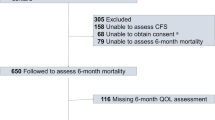Abstract
Objective
To evaluate short- and long-term outcomes of elderly patients (≥ 65 years) treated at an intermediate care unit (IMCU) and to identify outcome predictors.
Design and setting
Prospective observational study in the IMCU of a university teaching hospital.
Participants
We studied 412 patients over 8 months, classified into three groups: under 65 years (control group, n = 158), 65–80 (n = 186), and > 80 (n = 68).
Measurements
At admission: APACHE II, TISS-28 first day, Charlson Index, diagnosis, and prior Barthel Index. Outcome measures: in-hospital mortality, length of stay, discharge destination, and 2-year mortality and readmissions. Data analysis included multivariate logistic regression and receiver operating characteristics area under the curve (ROC AUC).
Results
No statistically significant differences between groups were observed in hospital mortality (14.1%), discharge to a long-term facility (2.7%), or 2-year readmissions (1.2 ± 2.1). However, hospital stay was longer in patients aged 65–80 years (14 vs.10 days) and 2-year mortality was higher in those 65 or over (34% vs.10.6%). In the overall series in-hospital mortality was predicted by APACHE II, first-day TISS-28, and diagnosis (ROC AUC 0.81), and 2-year mortality by Charlson Index and age (ROC AUC 0.77). In the elderly patients 2-year mortality was predicted by Charlson and Barthel indices (ROC AUC 0.70).
Conclusions
Illness severity and therapeutic intervention at admission to IMCU were predictors of short-term mortality, whereas the strongest predictor of long-term mortality was comorbidity. Our results suggest that comprehensive assessment of elderly patients at admission to IMCUs may improve outcome prediction.

Similar content being viewed by others
References
Cheng DC, Byrick RJ, Knobel E (1999) Structural models for intermediate care areas. Crit Care Med 27:2266–2271
Dhond G, Ridley S, Palmer M (1998) The impact of a high-dependency unit on the workload of an intensive care unit. Anaesthesia 53:841
Havill JH, Cranston D (1998) The place of the high dependency unit in a modern New Zealand hospital. N Z Med J 111:203–205
Quality of life after mechanical ventilation in the aged study investigators (2002) 2-month mortality and functional status of critically ill adult patients receiving mechanical ventilation. Chest 121:549–558
Djaiani G, Ridley S (1997) Outcome of intensive care in the elderly. Anaesthesia 52:1130–1136
Somme D, Maillet JM, Gisselbrecht M, Novara A, Ract C, Fagon JY (2003) Critically ill old and the oldest-old patients in intensive care: short- and long-term outcomes. Intensive Care Med 29:2137–2143
Hamel MB, Davis RB, Teno JM, Knaus WA, Lynn J, Harrel FJr, Galanos A, Wu AW, Phillips RS (1999) Older age, aggressiveness of care, and survival for seriously ill, hospitalized adults. Ann Intern Med 131:721–728
De Silva RJ, Anderson A, Tempest H, Ridley S (2001) Sequential organ scoring as a measure of effectiveness of care in the high-dependency unit. Anaesthesia 56:850–854
Brooks N (2000) Quality of life and the high-dependency unit. Intensive Crit Care Nurs 16:18–32
Ip S, Leung YF, Ip CY, Mak WP (1999) Outcomes of critically ill elderly patients: Is high-dependency care for geriatric patients worthwhile? Crit Care Med 27:2351–2357
Torres OH, Benito S, Ruiz D, Montiel JA, Francia E, Vázquez G (2003) Outcome of elderly patients in an Intermediate Care Area. Sixteenth Annual Congress from the European Society of Intensive Care Medicine; 2003 Oct 5–8; Amsterdam, Netherlands. Intensive Care Med 29 [Suppl 1]:115
Knaus WA, Draper EA, Wagner DP, Zimmerman JE (1985) APACHE II: a severity of disease classification system. Crit Care Med 13:818–829
Miranda DR, de Rijk A, Schaufeli W (1996) Simplified Therapeutic Intervention Scoring System: the TISS-28 items-results from a multicenter study. Crit Care Med 24:64–73
Mahoney FI, Barthel DW (1965) Functional evaluation: the Barthel Index. Maryland State Med J 14:61–65
Wade DT, Collin C (1988) The Barthel ADL Index: a standard measure of physical disability? Int Disabil Studies 10:64–67
Charlson ME, Pompei P, Ales KL, MacKenzie CR (1987) A new method of classifying prognostic comorbidity in longitudinal studies: development and validation. J Chronic Dis 40:373–383
Kleinbaum DG, Kupper LL, Muller KE (1988) Applied regression analysis and other multivariables methods. PWS-Kent, Boston
Porath A, Reuveni H, Grinberg G, Lieberman D (1995) The intermediate care unit as a cost-effective option for the treatment of medical patients in critical condition. Isr J Med Sci 31:674–680
Pirret AM (2002) Utilizing TISS to differentiate between intensive care and high-dependency patients and to identify nursing skill requirements. Intensive Crit Care Nurs 18:19–26
Wakefield CH, Corry R, Dodds R, Park L Lee A, Fearon KCH (2000) Activities and outcome in the surgical high-dependency setting. Br J Surg 87 [Suppl 1]:54
Ching CK, Yam LY, Lee CH (1997) 6-month survival of patients admitted to a medical high dependency unit. Chest 112 [Suppl 3]:85S
Kass JE, Castriotta RJ, Malakoff F (1992) Intensive care unit outcome in the very elderly. Crit Care Med 20:1666–1971
Mayer-Oakes SA, Oye RK, Leake B (1991) Predictors of mortality in older patients following medical intensive care: the importance of functional status. J Am Geriatr Soc 39:862–868
Roche VML, Kramer A, Hester E, Welsh CH (1999) Long-term functional outcome after intensive care. J Am Geriatr Soc 47:18–24
Boumendil A, Maury E, Reinhard I, Luquel L, Offenstadt G, Guidet B (2004) Prognosis of patients aged 80 years and over admitted in medical intensive care unit. Intensive Care Med 30:647–654
Nierman DM, Schechter CB, Cannon LM, Meier DE (2001) Outcome prediction model for very elderly critically ill patients. Crit Care Med 29:1853–1859
Acknowledgements
We thank Carolyn Newey for editorial assistance.
Author information
Authors and Affiliations
Corresponding author
Additional information
This article is discussed in the editorial available at: http://dx.doi.org/10.1007/s00134-006-0172-z
Electronic supplementary material
Rights and permissions
About this article
Cite this article
Torres, O.H., Francia, E., Longobardi, V. et al. Short- and long-term outcomes of older patients in intermediate care units. Intensive Care Med 32, 1052–1059 (2006). https://doi.org/10.1007/s00134-006-0170-1
Received:
Accepted:
Published:
Issue Date:
DOI: https://doi.org/10.1007/s00134-006-0170-1




